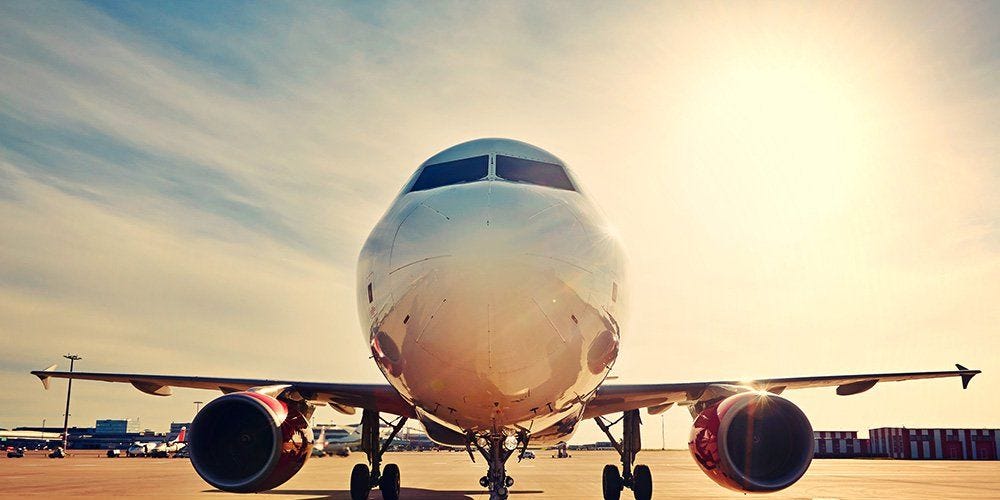Okay, I know what you’re thinking, “this is going to be some ridiculous analysis on food usage in the airline industry.” Nope. That was last week. This week we’ll get into gas laws, and how airplanes go about pressurizing their cabins. So sit back and relax, maybe you’ll even learn something!
If you’ve been on a plane, you know it goes pretty high up in the sky. So high, in fact, that if you were outside you wouldn’t be able to breathe. The air is so thin that it doesn’t contain enough oxygen for your brain and body to function. Just like if you climbed Mt. Everest—you need an oxygen tank as you get close to the peak. Mt. Everest is about 29,000 feet tall. Airplanes fly anywhere from 30,000 to 38,000 feet high. All this means is to be able to fly that high up, you’re going to need more oxygen—and really the only way to do that is to pressurize the cabin. That way, you can fill it with all the necessary gases that allow you to breathe normally. This is why, if the cabin were to “depressurize”, oxygen masks would fall from the ceiling. These masks are connected to pressurized tanks so that they can feed you just the right amount of air. But interestingly enough, oxygen isn’t the only reason why we need pressurized cabins.
Our bodies are used to living under a certain pressure. Our blood pressure—and any organ for that matter—is designed for sea level. This basically means blood pushes out on our skin with the same pressure that the air pushes in. This means if this air pressure all of the sudden goes away, and our bodies continue to push out, there’s nothing to resist it, and things can get very dangerous; quickly. Don’t worry though, it’s not that severe unless you’re in space. Otherwise, there are slower, less imminent effects when you’re at an airplane’s cruising altitude. Over time, these can include internal bleeding and damaged eardrums.
Now that we’ve made a significant case for pressurized cabins, how do planes actually do it? Think of it like a balloon that you can open and close. On the ground, the balloon can just sit there undisturbed—because you’re at a normal altitude. But as you ascend, the balloon (a valve) closes and holds that pressure. If you need to bring in some fresh air, you can pump it in and open the valve, ensuring the same amount of air goes out that comes in. So, the balloon is constantly releasing and pumping in air to hold the same size (pressure). Now we can examine what pressure they choose to use.
Airplanes typically pressurize their cabins to 8,000 feet above sea level. This was deemed a safe pressure to stay at for extended periods of time while decreasing the energy (and therefore fuel) needed to maintain it. That being said, it’s still not what we’re typically used to. Maybe you’ve heard the classic advice when you travel to a city like Denver: drink a lot of water. Otherwise, you’re prone to headaches. That’s the altitude. The gases in your body are pushing out more relative to the air around them and that causes pressure to build up in your ears, which can lead to headaches. This exact theory can be applied to planes—and is why people often get headaches after traveling.
This, however, is exactly the answer to our question. When a snack bag is sealed, it’s sealed with the pressure equivalent to the air in the factory where it was made. If the factory was at sea level, the chip bag’s internal pressure will be sea level. So, when you bring it up in the sky on a plane, the bag continues to push out with sea-level pressure, while the air around pushes in with lower pressure. This causes the bag to puff up.
The same is true in reverse. If you are drinking out of a water bottle up at 30,000 feet and close it. You are sealing in air pressurized at about 8,000 feet. When you finally land, the sea-level pressurized air pushes in on the bottle much more than the 8,000-foot air can push out. This causes your bottle to almost crumple up.
Tada! There’s your answer. Oh were you looking for a proof of the Ideal Gas Law? No? Okay phew. Thank you so much for reading this week’s edition of It’s Not Rocket Science. Join us next week for a discussion on something… else (I’m very noncommittal). Happy Wednesday!
Check us out on social media!
Check out last week’s newsletter here.
For more details…
Cover Image: https://www.womenshealthmag.com/life/a19996567/flight-attendant-travel-hacks/
[1] https://www.vox.com/the-goods/2018/9/21/17887130/jet-airways-airplane-cabin-pressure




